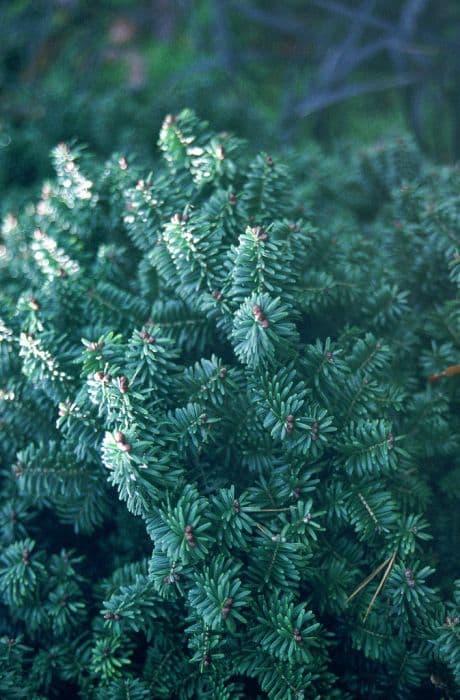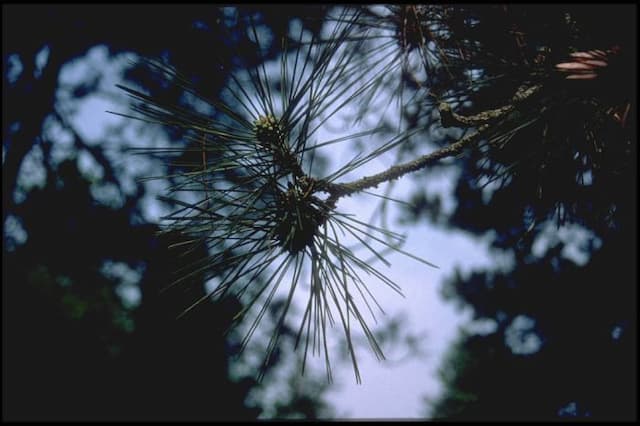Korean fir 'Silberlocke' Abies koreana 'Silberlocke'

ABOUT
'Silberlocke' is an evergreen conifer making a small tree of bushy habit. Leaves dark green, but curled upwards to show the silvery white undersides. Purple cones borne on young plants
About this plant
 Names
NamesFamily
Pinaceae
Synonyms
Korean Fir, Silverlock Korean Fir, Silberlocke Fir, Horstmann's Silberlocke Fir
Common names
Abies koreana 'Silberlocke'.
 Characteristics
CharacteristicsLife cycle
Perennials
Foliage type
Evergreen
Color of leaves
Green
Height
10-15 feet (3-4.5 meters)
Spread
4-6 feet (1.2-1.8 meters)
Plant type
Tree
Hardiness zones
5
Native area
Korea
Benefits
 General Benefits
General Benefits- Ornamental Appeal: Its unique curled needles with silvery undersides add visual interest to landscapes.
- Evergreen Nature: Provides year-round greenery and structure in gardens, even in winter months.
- Low Maintenance: Requires minimal pruning and is generally pest-resistant, making it easy to care for.
- Compact Growth: Suitable for small gardens due to its slow-growing, compact habit.
- Cold Hardy: Tolerant of cold temperatures, making it a suitable choice for cooler climates.
- Drought Resistance: Once established, it can withstand periods of dry conditions.
- Wildlife Support: Can offer shelter and food for birds and other wildlife.
- Seasonal Interest: Cones provide additional decorative elements, and the foliage may take on purple hues in winter.
- Soil Versatility: Adapts to a range of soil types, though it prefers well-drained, acidic soils.
 Medical Properties
Medical PropertiesThis plant is not used for medical purposes.
 Air-purifying Qualities
Air-purifying QualitiesThis plant is not specifically known for air purifying qualities.
 Other Uses
Other Uses- The Korean fir 'Silberlocke' can be used in bonsai culture, where its unique curled needles and compact growth make it an exotic and attractive specimen.
- The curled foliage of the Korean fir 'Silberlocke' can be used in floral arrangements, particularly winter displays, for its interesting texture and form.
- Wood from the Korean fir 'Silberlocke' can be utilized in crafting small wooden items such as ornaments or decorative boxes, as it is a softwood that is relatively easy to work with.
- The tree can be planted in large outdoor planters for urban or rooftop gardens, providing evergreen structure and interest in constrained spaces.
- Its cones can be collected and used as natural decorations during the holiday season, sometimes sprayed with metallic paints for added festive appeal.
- With its slow growth and attractive form, the Korean fir 'Silberlocke' is suitable for use in miniature train or fantasy landscape modelling.
- The dense branching of the Korean fir 'Silberlocke' provides shelter for birds and other small wildlife when used in a garden setting.
- The tree's form and variegated needles make it an interesting focal point for night lighting in landscape design.
- Gardeners may use clippings from pruning the Korean fir 'Silberlocke' to create wreaths and other decorative crafts, especially during the winter holidays.
- Dried cones of the Korean fir 'Silberlocke' can be used to create homemade potpourri mixtures, often combined with essential oils and spices for scent.
Interesting Facts
 Feng Shui
Feng ShuiThe Korean fir is not used in Feng Shui practice.
 Zodiac Sign Compitability
Zodiac Sign CompitabilityThe Korean fir is not used in astrology practice.
 Plant Symbolism
Plant Symbolism- Endurance and Longevity: As an evergreen, Abies koreana 'Silberlocke', more commonly known as Korean fir, represents endurance and the ability to withstand hardships, reflecting evergreens' ability to maintain their foliage throughout the seasons.
- Purity: The Korean fir's crisp, curled needles with their silvery underside can symbolize purity and a fresh start, akin to the pristine quality of a fresh snowfall.
- Peace: Evergreens are often associated with peace and tranquility, offering a visual reminder of the quiet and calm of the forest where they thrive.
- Resilience: The adaptability and resilience of Korean fir in various soils and conditions can symbolize human resilience in the face of challenge.
- Hope: The evergreen nature of this fir means it remains green even during the cold, dark winter months, offering a symbol of hope and the promise of the return of spring.
 Water
WaterKorean fir 'Silberlocke' prefers consistent moisture but is also drought tolerant once established. It should be watered thoroughly, ensuring that the root zone is reached. On average, during the growing season, water the plant with 1 to 2 gallons per week, depending on rainfall and soil conditions. During winter or dormant periods, reduce watering but do not allow the soil to dry out completely. Adjust frequency based on soil drainage; sandy soils require more frequent watering while clay soils retain moisture longer.
 Light
LightKorean fir 'Silberlocke' thrives in full sun to partial shade. It is best to plant it in a location where it receives at least six hours of direct sunlight per day, ideally in the morning with some afternoon shade to protect it from intense, late-day sun. Fully shaded areas should be avoided as they can lead to poor growth and reduced hardiness.
 Temperature
TemperatureKorean fir 'Silberlocke' is cold hardy and can withstand temperatures as low as -40 degrees Fahrenheit. The ideal temperature range for this plant is between 60 and 70 degrees Fahrenheit during its active growth period. Protection from extreme heat is advisable, as very high temperatures may stress the plant.
 Pruning
PruningPruning of the Korean fir 'Silberlocke' is generally not required for health but may be done for aesthetic shaping. The best time to prune is during the dormant season, before spring growth begins. Lightly trim to maintain its desired shape or size, but avoid heavy pruning, as firs do not regenerate foliage from old wood. Occasional removal of dead or broken branches can be carried out as needed.
 Cleaning
CleaningNot needed
 Soil
SoilKorean Fir 'Silberlocke' thrives in well-draining, acidic to neutral soil with a pH ranging from 5.5 to 7.0. A mix of peat, perlite, and pine bark suits it well, mimicking its natural, forested habitat.
 Repotting
RepottingKorean Fir 'Silberlocke' generally does not require frequent repotting as it is slow-growing; repotting every 3-5 years or when rootbound is sufficient.
 Humidity & Misting
Humidity & MistingKorean Fir 'Silberlocke' prefers moderate to high humidity but is adaptable to less humid conditions once acclimated, avoiding excessively dry air to prevent needle desiccation.
 Suitable locations
Suitable locationsIndoor
Ensure bright light, cool temps, and high humidity.
Outdoor
Full sun, well-draining soil, protect in harsh winters.
Hardiness zone
5-7 USDA
 Life cycle
Life cycleAbies koreana 'Silberlocke', commonly known as Korean Fir, begins its life cycle as a seed, often requiring a period of cold stratification to simulate winter conditions and break dormancy. Once conditions are favorable, the seed germinates and the plant emerges as a seedling, featuring the distinctively curled needles for which the cultivar is named. As it matures into a sapling and adult tree, it will develop a conical shape with horizontally spreading branches and can reach up to 10-15 feet in height. During maturity, it produces upright, purple cones that contrast with the silver underside of the curled foliage. When fully grown, the Korean Fir will reproduce by producing seeds within its cones, which are then dispersed by wind, gravity, or wildlife, completing its reproductive cycle. As a conifer, it can live for many decades, continuing to grow and produce cones annually.
 Propogation
PropogationPropogation time
Summer to Autumn
The most popular method of propagation for the Korean Fir 'Silberlocke' is by seed. To properly germinate, the seeds usually require a pre-treatment consisting of cold stratification, a process in which they are subjected to cold and moist conditions for several weeks to mimic winter conditions. This is generally done by placing the seeds in a sealed bag with moist sand or vermiculite and refrigerating them for about one to two months. After stratification, seeds are sown in well-draining soil in containers or a nursery bed and kept under controlled conditions until they are strong enough to be transplanted. Germination rates are variable and growing Korean Fir 'Silberlocke' from seed can be a slow process, but this method allows for the production of many plants once successfully accomplished.









